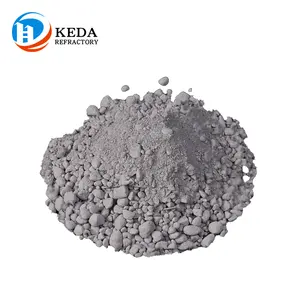
Lightweight Refractory Castable Boilers Light Weight Refractory Insulation Castable Cement For Rotary Furnace

KedaLightweight High-temperature Electric Melting Azs Castable For Refractory Castable Cement Glass Furnace




















Refractory cement, also known as refractory mortar, is a type of cement that is designed to withstand high temperatures and harsh conditions. It is used in various applications where conventional cement would break down, such as in furnaces, kilns, fireplaces, and other heat-resistant structures.
Refractory cement is formulated to withstand extremely high temperatures, often in excess of 2,000 degrees Fahrenheit (1,093 degrees Celsius). This makes it suitable for applications where regular cement would not be able to withstand the heat. It has excellent adhesion and bonding properties, allowing it to bond well with refractory bricks, ceramic fiber, and other heat-resistant materials. This ensures the integrity of the structure in high-temperature environments. High temperature refractory cement is designed to resist thermal shock, which occurs when a material is subjected to rapid temperature changes. This property is crucial in applications where heating and cooling cycles are frequent. It exhibits chemical stability in harsh environments, including exposure to acids, alkalis, and other corrosive substances. This stability is essential for the durability of refractory linings.
Refractory cement typically has specific setting and curing requirements. It may require a curing process involving controlled temperature and humidity to achieve optimal strength and heat resistance. Different grades and types of castable refractory cement are formulated for specific temperature ranges and applications. Selection depends on the intended use and the maximum temperature the cement will be exposed to.
Refractory cement is widely used in the construction and repair of furnaces, kilns, fireplaces, and incinerators, providing a heat-resistant lining that withstands the extreme temperatures generated in these industrial processes. It is used for repairing and constructing fireplaces and chimneys. Refractory cement ensures that the structure can handle the high temperatures generated by burning wood or other fuels. Refractory cement is employed in the construction and maintenance of incinerators and industrial ovens where materials need to be subjected to high temperatures for processing or disposal. In the glass and metal industries, refractory cement for forge is used to line furnaces and crucibles, where materials are melted at extremely high temperatures for shaping and production processes. It finds applications in the construction and maintenance of boilers and power plants, providing a heat-resistant lining that can withstand the intense heat generated by combustion. Refractory cement is used for repairs in applications where standard cement would fail due to exposure to high temperatures, such as repairing cracks in firebricks or lining.
Ensure that the surfaces to be bonded are clean, dry, and free from contaminants to promote proper adhesion. Follow the manufacturer's instructions regarding the mixing ratio and water content for the specific refractory cement being used. Allow sufficient time for the cement refractory to cure properly. Follow the recommended curing process, which may involve controlled temperature and humidity conditions. Choose the appropriate grade of refractory cement based on the maximum temperature the material will be exposed to in its intended application. Always refer to the manufacturer's guidelines and specifications for the refractory cement one is using, as different products may have specific requirements for mixing, application, and curing.